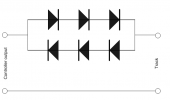RichardG
Western Thunderer
Making a complete guess, perhaps the motor starts to run on a voltage lower than the minimum output voltage from the controller. If so, here is an idea you can build for pennies. It is a variation on the resistors idea and it exploits the characteristic of semiconductors made from silicon. I am also guessing, the maximum speed is a secondary consideration.

Buy six 3 amp (or bigger) silicon diodes and connect them together like this. Then see if things are any better. If so, you could put the diodes permanently inside the loco or tender, and you will have a loco tailored to work on your controller.
Technically, the circuit uses the forward voltage drop of a silicon P-N junction to reduce the voltage from the controller across its speed range. The drop is about 0.7 volts per diode, so this lops off about 2 volts in all. Make sure you use silicon diodes not germanium ones.

Buy six 3 amp (or bigger) silicon diodes and connect them together like this. Then see if things are any better. If so, you could put the diodes permanently inside the loco or tender, and you will have a loco tailored to work on your controller.
Technically, the circuit uses the forward voltage drop of a silicon P-N junction to reduce the voltage from the controller across its speed range. The drop is about 0.7 volts per diode, so this lops off about 2 volts in all. Make sure you use silicon diodes not germanium ones.













